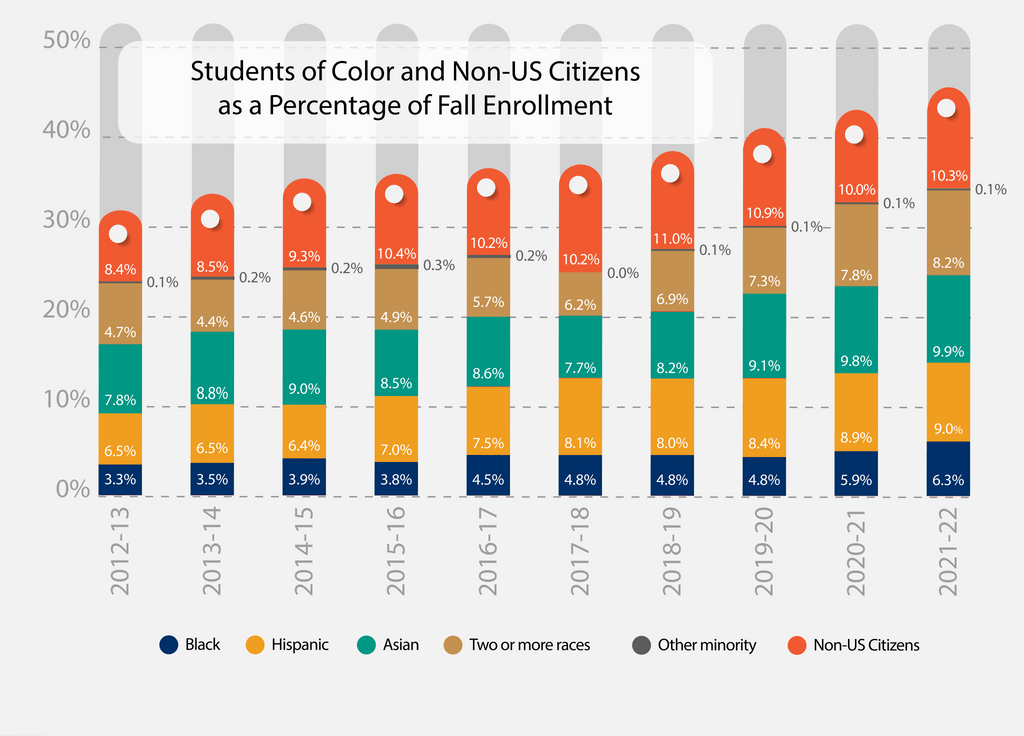Carleton’s Community Plan for Inclusion, Diversity, and Equity is a long-term, coordinated endeavor to improve life on campus for everyone.

On March 31, after a 16-month period of community review and input, the Board of Trustees unanimously endorsed Carleton’s Community Plan for Inclusion, Diversity, and Equity (IDE). The 40-page document, which was sent digitally to students, faculty, staff, and alumni, on April 15, revolves around five broad goals designed to anchor an ambitious 10-year initiative.
“We spent an appropriately significant period of time, with the help of Cambridge Hill Partners, to make sure we had a chance to speak to all the constituents of our community,” says trustee Alison von Klemperer ’82, P ’16, a member of the IDE Steering Committee. “As a result, the plan faithfully reflects the views of our students, our faculty, our staff, and our alumni. It’s unique to our college and speaks to who we are and how we think about issues of inclusion, diversity, and equity in a complex and changing landscape.”
Chico Zimmerman, the Hazel Lillian Amland Grose Professor of Classics, has worked on IDE-related issues throughout his tenure. He says that in order to ensure success it was important for the steering committee, of which he served as cochair together with trustee Jeninne McGee ’85, to create a baseline to help stakeholders understand where the college has already excelled and where it’s fallen short, and to help gauge progress moving forward. “We both looked at current data and historical data,” says Zimmerman. “We also heard from lots of alumni who have passion around the topic. All of that helped us stay focused.”
Both Zimmerman and von Klemperer stress that what’s most significant is the holistic nature of the effort. The broader goals were created to be “durable,” meaning that they can withstand the ebb and flow of institutional life (leadership changes, economic pressures, etc.). The specific strategies suggested under each of the goals, however, are meant to function as basic building blocks; ensuring that both necessary resources and initiatives are put in place to build momentum, and that additions and alterations can be created in real time, as solutions are tested, anecdotes are shared, and collected data is evaluated.
“I’ve been here a really long time, and I can tell you that lots of people have done lots of work in this area,” says Zimmerman, who came to Carleton in 1989. “But it’s never been coordinated, focused, and aligned to specific, measurable objectives. And so, the biggest thing about this plan is that it’s an actual plan. We never had a plan before. We were always responding and reacting, and it was always piecemeal. It was well intentioned, and I think many of the things we did were useful, but it was never coordinated. Now we’re making public what we think we want to accomplish as an institution and we’re giving ourselves very specific areas that we can measure.”
A synopsis of the five broader goals and initial, attendant strategies outlined in the plan makes it clear, as von Klemperer explains, that Carleton’s Community Plan for IDE is “a living, breathing document” that can (and must) be owned by the entire community— including the Board of Trustees itself, which she says has prioritized recruitment needed to increase diversity in its own ranks in the near term.
The following was culled from an executive summary drafted to accompany the release of Carleton’s Community Plan for Inclusion, Diversity, and Equity.
Goal One: Build the institutional capacity, resources, and dedicated leadership required to engage in the work of inclusion, diversity, and equity broadly, including implementing and sustaining the IDE Plan.
This goal is about building the college’s commitment to IDE and the ability to carry it out, making equity and inclusion a central factor in all of its processes and actions. This guarantees that IDE efforts won’t be an “add-on” to business as usual, but will fundamentally transform the experience of living and working on campus. Close attention was also paid to making sure that the needed work is distributed equitably so that no one person or group bears too much of the burden.
The strategies for achieving this goal include: Creating an IDE office led by a chief diversity officer, developing and implementing ways to audit equity throughout the college, and providing and incentivizing training in equity-minded, inclusive decision making for people who are in leadership positions.
Goal Two: Significantly increase representation of students, faculty, and staff from underrepresented populations.
Because the student population changes more quickly over time than the staff and faculty population, it’s important that Carleton continues to develop its networks and pipelines in order to recruit and retain a student body, staff, and faculty that represent the diversity of the nation and world to the greatest extent possible.
The strategies for achieving this goal include: Developing early intervention programs that address the satisfaction and academic success of students from underrepresented groups, creating a faculty recruitment strategy based on closer connections with organizations (including historically Black colleges and Hispanic-serving institutions), and developing equally robust and diverse staff recruitment pipelines.

Goal Three: Establish and sustain the resources and practices necessary to provide an equitable environment for all students, staff, and faculty to thrive.
The strategies for achieving this goal include: Developing a comprehensive student-support model, including but not limited to academic advising, counseling, and progress monitoring; ensuring that the ombuds program is independent and confidential; and providing gateway courses to ensure degree requirements can be met by students from a wider variety of educational backgrounds.
Goal Four: Integrate and sustain engagement with the principles of IDE, including the full diversity of perspectives, experiences, and intellectual contributions of historically underrepresented voices.
The academic enterprise is built to test ideas and points of view both familiar and new. Carleton hopes to better live up to this ideal by welcoming further contributions by members of the campus community whose backgrounds and identities haven’t always been elevated.
The strategies for achieving this goal include: Designating IDE-specific development funds for designing or redesigning curriculum; exploring the creation of a Center for Race, Gender, Indigeneity, and Social Justice; hosting facilitated community-wide discussions highlighting underrepresented scholars and community members; and exploring new and enhanced options for recognizing student IDE work.
Goal Five: Demonstrate Carleton’s commitment to measurable improvement of IDE outcomes (retention, recruitment, achievement, thriving and belonging, and cultural competence) through data collection and analysis and transparent communication.
A more robust system of measurement and accountability will help determine what is and isn’t working, on both a programmatic and individual level.
The strategies for achieving this goal include: Establishing baselines and measures of the effectiveness of programs set up to promote IDE, assigning clear roles in pursuit of the desired outcomes, identifying the group or groups that have responsibility for oversight, and communicating progress in the areas measured.

Now that the plan has been approved and shared with all Carleton community members, the work of prioritization and implementation will begin. This will involve a comprehensive review of needed resources.
Trustee Alison von Klemperer notes that “over the next 10 years there will be many opportunities to consider giving as a way to support IDE on campus.” And for those interested in contributing to help subsidize initiatives as the 2021–22 fiscal year comes to a close, a list of initial funding opportunities has begun to emerge. The categories include:
- Create an IDE office that is led by a vice president-level chief diversity officer who reports to the president, is a member of the president’s senior staff, and who is supported with the resources necessary to ensure success.
- Develop and provide ongoing antiracism education for all campus groups and stakeholders, including students, faculty, staff, trustees, and alumni leadership.
- Establish a dedicated fund to improve recruitment of Indigenous students and remove financial barriers negatively impacting their enrollment and retention, including the college’s policy of meeting their full demonstrated financial need, thereby increasing representation and graduation of Indigenous students.
- Strengthen the commitment to and stability of the Africana studies program with dedicated faculty lines and appropriate resources.
- Establish funding and logistical support that encourages student leaders to gather on campus and to participate in conferences and coordinate with peers on other campuses in discussions of IDE initiatives and work.
- Support the ongoing work of the College in this area through gifts to the Annual Fund’s IDE designation.
Learn more about IDE funding opportunities and view the entirety of Carleton’s Community Plan.
